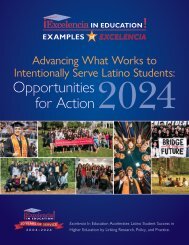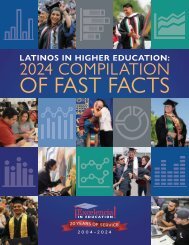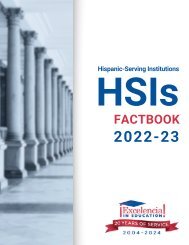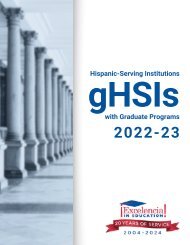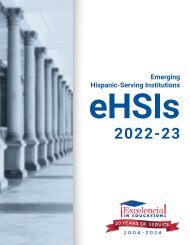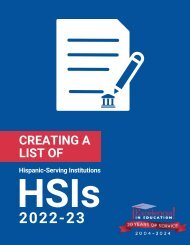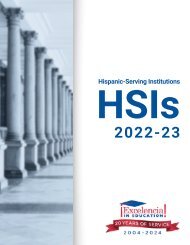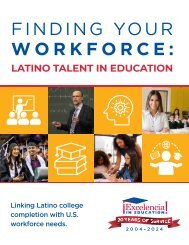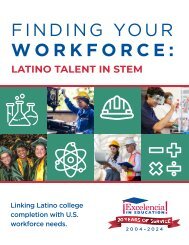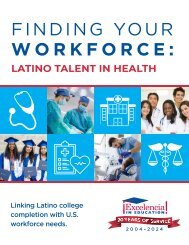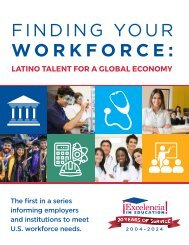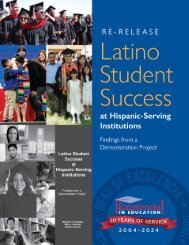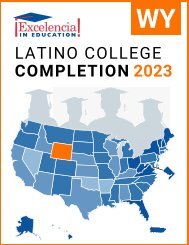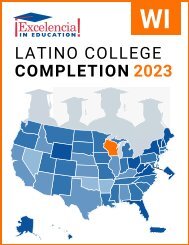Latino College Completion 2023: Alabama
You also want an ePaper? Increase the reach of your titles
YUMPU automatically turns print PDFs into web optimized ePapers that Google loves.
AL
LATINO COLLEGE COMPLETION:<br />
ALABAMA – <strong>2023</strong><br />
For the U.S. to regain the top ranking in the world for college degree<br />
attainment, <strong>Latino</strong>s will need to earn 6.2 million degrees by 2030. 1<br />
FAST FACTS<br />
STATE RANKING:<br />
<strong>Alabama</strong> had the 34th largest<br />
<strong>Latino</strong> population in the U.S.<br />
K-12 POPULATION:<br />
In <strong>Alabama</strong>, 8% of the K-12<br />
population was <strong>Latino</strong>. 2<br />
POPULATION:<br />
In <strong>Alabama</strong>, 5% of the population<br />
was <strong>Latino</strong>. 2<br />
MEDIAN AGE:<br />
The median age<br />
of Hispanics in<br />
<strong>Alabama</strong> was 24,<br />
compared to 43<br />
for White non-<br />
Hispanics. 2<br />
24<br />
Hispanics<br />
43<br />
White<br />
non-Hispanics<br />
ENROLLMENT:<br />
In <strong>Alabama</strong>, 18% of Hispanics<br />
(ages 18 to 34) were enrolled in<br />
higher education, compared to<br />
23% of White non-Hispanics. 2<br />
DEGREE ATTAINMENT:<br />
In <strong>Alabama</strong>, 25% of Hispanic adults<br />
(25 and older) had earned an associate<br />
degree or higher, compared to 39%<br />
of White non-Hispanic adults. 2<br />
Hispanic Adults = 2.5 of 10<br />
To reach the degree attainment goal by 2030, the U.S. can: close<br />
the degree completion gap by accelerating <strong>Latino</strong> completion while<br />
increasing for all students and scale up programs and initiatives that<br />
work for <strong>Latino</strong>, and all, students. The following demographics,<br />
institutional data, and practices inform <strong>Latino</strong> degree attainment.<br />
ENROLLING: Top 5 Institutions (Hispanic Undergraduates) in <strong>Alabama</strong>, 2021-22<br />
Institution<br />
Sector<br />
Grand<br />
Total<br />
NOTE: We use the terms <strong>Latino</strong> and Hispanic interchangeably in this factsheet.<br />
Hispanic<br />
Total<br />
Source: Excelencia in Education analysis using U.S. Department of Education, National Center for<br />
Education Statistics (NCES), Integrated Postsecondary Education Data System (IPEDS), 2021 Fall<br />
Enrollment, Graduation Rates Survey and Institutional Characteristics Survey.<br />
%<br />
Hispanic<br />
1 The University of <strong>Alabama</strong> Public, 4-year 30,725 1,687 5%<br />
2 Auburn University Public, 4-year 24,782 947 4%<br />
3 University of <strong>Alabama</strong> at Birmingham Public, 4-year 13,284 889 7%<br />
John C Calhoun State Community<br />
4 <strong>College</strong><br />
Public, 2-year 6,795 575 8%<br />
5 Troy University Public, 4-year 10,916 495 5%<br />
ASSOCIATE DEGREES: Top 5 Institutions Awarding to Hispanics in <strong>Alabama</strong>, 2020-21<br />
Institution<br />
Sector<br />
Grand<br />
Total<br />
Hispanic<br />
Total<br />
%<br />
Hispanic<br />
John C Calhoun State Community<br />
1 <strong>College</strong><br />
Public, 2-year 1,368 79 6%<br />
2 Snead State Community <strong>College</strong> Public, 2-year 408 75 18%<br />
3 Northeast <strong>Alabama</strong> Community <strong>College</strong> Public, 2-year 429 57 13%<br />
George C Wallace State Community<br />
4 <strong>College</strong>-Hanceville<br />
Public, 2-year 975 51 5%<br />
Private forprofit,<br />
4-year<br />
5 Columbia Southern University<br />
1,582 49 3%<br />
BACHELOR DEGREES: Top 5 Institutions Awarding to Hispanics in <strong>Alabama</strong>, 2020-21<br />
Institution<br />
Sector<br />
Grand Hispanic %<br />
Total Total Hispanic<br />
1 The University of <strong>Alabama</strong> Public, 4-year 7,278 364 5%<br />
2 Auburn University Public, 4-year 5,641 192 3%<br />
Private forprofit,<br />
4-year<br />
3 Columbia Southern University<br />
3,131 163 5%<br />
4 University of <strong>Alabama</strong> at Birmingham Public, 4-year 2,870 131 5%<br />
5 Troy University Public, 4-year 2,326 100 4%<br />
White Adults = 3.9 of 10<br />
1 Projections to 2030: Excelencia in Education. (2020). Ensuring America’s Future: Benchmarking <strong>Latino</strong><br />
<strong>College</strong> <strong>Completion</strong> to 2030. Excelencia in Education. Washington, D.C.<br />
2 U.S. Census Bureau, 2021 American Community Survey 1-Year Estimates
<strong>Alabama</strong> Gap in Degree <strong>Completion</strong><br />
Closing the degree completion gap can be tracked<br />
by the 4 measures shown below. Alone, none<br />
of these measures capture the entire “story” of<br />
degree completion. However, in combination,<br />
they provide a useful picture of the gap in degree<br />
attainment between Hispanic and White non-<br />
Hispanic cohorts in a single year.<br />
Graduation Rate — Total percentage of students<br />
who graduated within 150% of normal time for<br />
first-time, full-time freshmen. This incorporates<br />
students that graduated in 3 years at two-year<br />
institutions, or in 6 years at four-year institutions.<br />
Transferred to Another Institution —<br />
Percentage of students that transferred to another<br />
institution and did not complete a degree.<br />
Still Enrolled — Percentage of students that are<br />
still enrolled at the point of 150% normal time to<br />
completion.<br />
No Longer Enrolled — Percentage of students<br />
that are no longer enrolled at the point of 150%<br />
normal time to completion.<br />
At two-year institutions, Hispanics’<br />
graduation rate was 1%-point<br />
lower than that of their White<br />
non-Hispanic peers in <strong>Alabama</strong>.<br />
TWO-YEAR INSTITUTIONS<br />
37%<br />
7%<br />
24%<br />
33%<br />
WHITE<br />
-1%<br />
43%<br />
9%<br />
16%<br />
32%<br />
HISPANIC<br />
DEGREE OUTCOMES<br />
■ No Longer Enrolled<br />
■ Still Enrolled<br />
■ Transferred to<br />
Another Institution<br />
■ Graduation Rate<br />
*Percentages may not add up to 100% due to rounding.<br />
At four-year institutions, Hispanics’<br />
graduation rate was 10%-points<br />
lower than that of their White<br />
non-Hispanic peers in <strong>Alabama</strong>.<br />
FOUR-YEAR INSTITUTIONS<br />
2%<br />
12%<br />
18%<br />
68%<br />
WHITE<br />
2%<br />
-10%<br />
18%<br />
22%<br />
58%<br />
HISPANIC<br />
NOTE: Outcomes shown are for students at two-year institutions who started in Fall 2018, and<br />
for students at four-year institutions who started in Fall 2015.<br />
Source: Excelencia in Education analysis using the U.S. Department of Education, National<br />
Center for Education Statistics (NCES), Integrated Postsecondary Education Data System, 2021<br />
Graduation Rates Survey and the Institutional Characteristics Survey.<br />
Examples of What Works for <strong>Latino</strong> Students<br />
There are institutions showing success in enrolling, retaining, and graduating <strong>Latino</strong> students. The following are examples of<br />
programs across the country with evidence of effectiveness in serving <strong>Latino</strong> students nominated for Examples of Excelencia.<br />
The Masters in School Psychology Program at the University of<br />
Texas at San Antonio supports <strong>Latino</strong> graduate students to effectively<br />
serve the growing number of <strong>Latino</strong> students in U.S. public schools.<br />
Nationally, <strong>Latino</strong>s are underrepresented in the area of school<br />
psychology so the program has a goal to increase the number of <strong>Latino</strong><br />
school psychologists in the U.S. Established in 2010, the Masters in<br />
School Psychology was designed to meet the curricular and practical<br />
training requirements for state and national licensure in school<br />
psychology. The Masters in School Psychology offers participants<br />
an intensive three-year, 66-hour program that requires students to<br />
complete 300-hours of school-based practicum experience completed<br />
under the supervision of licensed university faculty and site personnel.<br />
In their third year, students complete a full-time internship (1,200<br />
hours) in a school setting. The program also offers students a graduate<br />
certificate in bilingual assessment, which provides specialized training<br />
and experience for professional assessment and evaluation in Spanish.<br />
In 2018-2019, 60% of program graduates were <strong>Latino</strong> up from 53%<br />
in 2013-2014. In the same time frame <strong>Latino</strong> student enrollment has<br />
been around or above 50% each year. While all students have obtained<br />
internships approximately 95% of students have obtained paid internships.<br />
Student pass rates on the state licensing exam for psychology was 100%.<br />
For more information on institutional programs improving <strong>Latino</strong> student success in higher education, access Excelencia in<br />
Education’s Growing What Works database at http://www.edexcelencia.org/growing-what-works<br />
ENSURING AMERICA’S FUTURE BY INCREASING LATINO COLLEGE COMPLETION • WWW.EDEXCELENCIA.ORG




